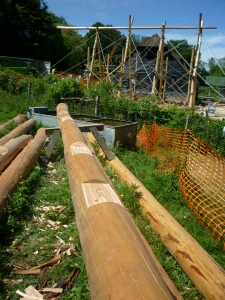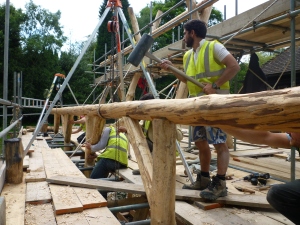The shape of the new building has been starting to emerge over the past few weeks as more of the timbers that form it have been added to the structure. When the body of the roof went on you started to get a feel for some of the finished dimensions, both internal and external.
Work has been continuing on the roof this week, but a couple of pretty interesting pieces of the structure have also been put into place as well.
The second set of wall plates have gone on, these hold the rafters as they go over the top of the straw bale walls. Now they are in you can see the gaps within which the bale walls will fit. Getting them into place with the roof and scaffolding in the way is a bit like threading the needle on a large scale. A gap in the scaffolding has a roller attached to it and then the telehandler is brought in to move the timber.
You should be able to see that it has already had the mortices cut in it so that it will slot straight onto the tenons that had been cut on top of the outer jowels.
Once the end was resting on the roller a bit of nifty reversing and driving is required to get the timber to roll over it up onto the scaffold into position.
Another timber that has been added to the structure this week is the newel post for the stairs. The stair treads will rediate out from this post as they wind around and up to the first floor, you can imagine resting a hand on it as you go upstairs. Its nice seeing some of the timbers going in that that will see the most of the people who will be living here.
It was lifted into the building mechanically but then raised into place using a block and tackle. The bottom of it rests on a padstone, and the top is attached to the rafters.
On a totally seperate note, if you followed my method for making elderflower champagne, now would be a good time to let a bit of pressure out of the bottles, I know from bitter experience just how messy a job it is cleaning up spills from exploded elderflower bottles and am hoping to save people some of the same trouble!










































